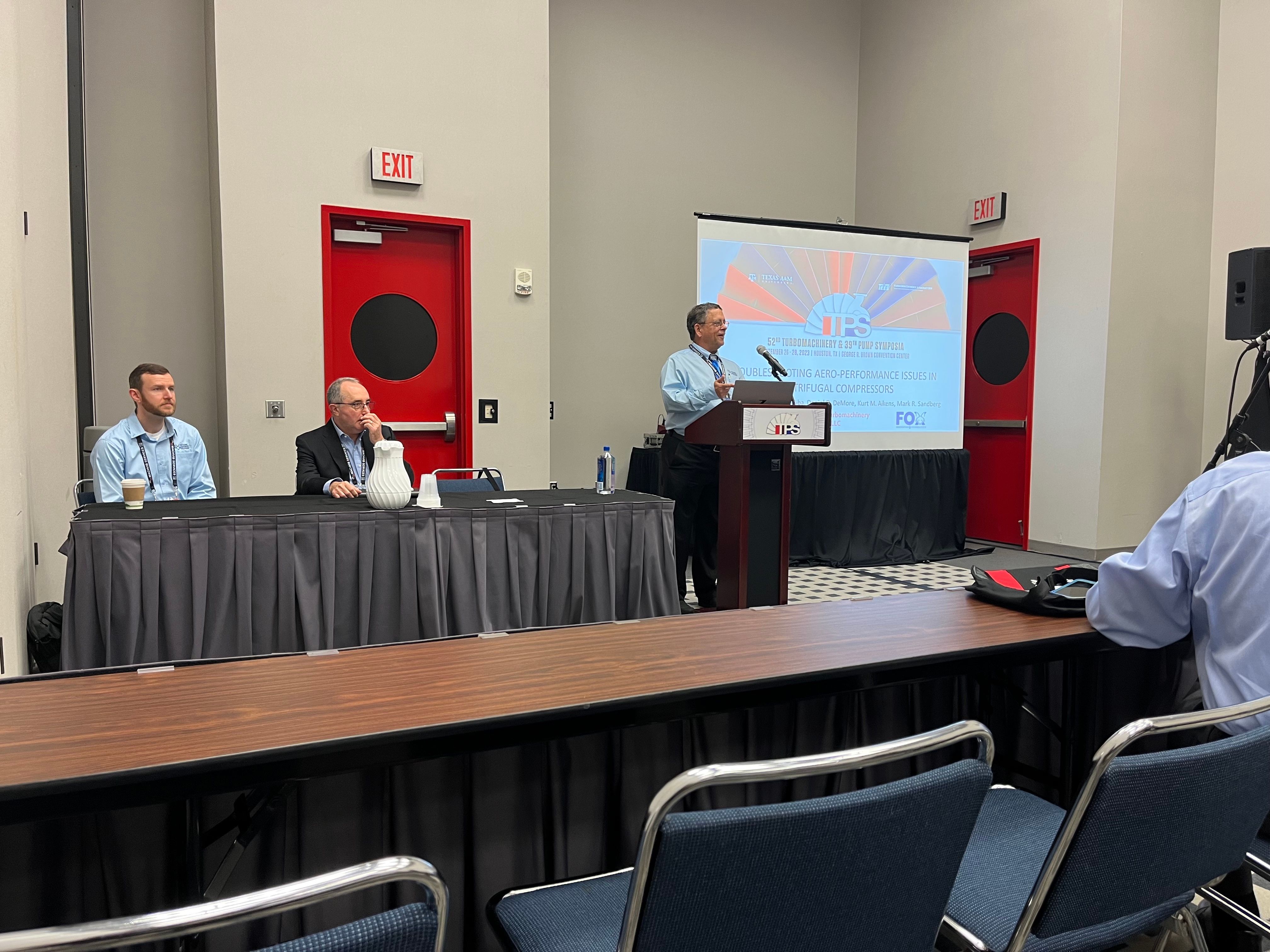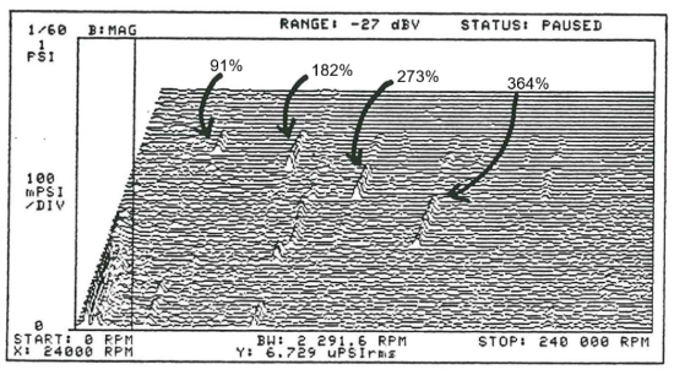TPS 2023: Steps to Resolving Aero-Performance Issues in Centrifugal Compressors
On the second day of TPS 2023, speakers outlined resolution steps for aero-performance-related issues in the field and on a production test stand.
On Wednesday morning at Turbomachinery & Pump Symposia (TPS) 2023, Yuri Biba, Principal Aerodynamic Engineer at Siemens Energy, Kurt Aikens, Aerodynamic Engineer at Fox Innovation & Technology, and Jim Sorokes, an aerodynamic independent consultant at Fox Innovation & Technology, presented a tutorial on Troubleshooting Aero-Performance Issues in Centrifugal Compressors. The session provided guidance on how to resolve aero-performance-related issues both in the field and on an OEM production test stand.
The session outlined several key steps in the resolution process, including:
- establishing effective communications between the parties involved in resolving the issue
- understanding the scope and/or history of the problem
- accumulating pertinent data, e.g., geometric, process, dates/times, etc.
- applying advanced analytical tools to help identify possible root causes and assess solutions
- documenting the solutions
Sorokes kicked off the discussion by asking the question, “Could we have avoided the problem in the first place? Did we do our due diligence in evaluating the technology that was used in the machine when it was being built?” He stressed that there must be open communication between the OEM and end user to define suitable levels of design verification.
“It’s best to identify any issues before the machine leaves the test stand,” he said.
The first step when troubleshooting aero-performance issues is to gain an understanding of the scope of the problem: Is it a mechanical issue, an aero-performance issue, or both? Is it only happening at low- or high-flow? Have I seen this issue before or is it new?
Jim Sorokes, an aerodynamic independent consultant at Fox Innovation & Technology, speaks at TPS 2023. Credit: Turbomachinery International

Ultimately, you want to determine whether the issue is specific to this type of compressor or this application. The OEM can help get this process started.
Next, determine who will be involved in this process—the OEM? Who from the client’s company? Is a third party involved? Who is in charge? Who’s leading the effort within each organization that’s involved?
Foundational in this process, however, is communication. “Communication is vital,” Sorokes said. “It must be open, honest, and thorough, and there must be a willingness to share data. Team members must Avoid back-channel communication," Sorokes said.
The next steps are:
- Establishing the urgency of the issue
- Establishing priority relative to ongoing activities
- Gathering and understanding data: frequency, trends, and vibration data
- Conduct a review of data and review operator logs
- Plot raw data to look for “strange” trends
- Waterfall diagrams (shown in figure below)
- Compare data to the original test stand results
- Gather physical evidence: photographs of flow patterns
Performance Trends
Waterfall diagram from the rotating-stall tutorial that enabled a troubleshooting team to assess how the sub-synchronous vibration changed with process flow, leading to identification of an impeller stall. Credit: Fox Innovation & Technology

Biba discussed trends in performance testing, including excess internal leakage, inlet and discharge losses, compressor fouling corrosion, and the impact of various manufacturing assembly mistakes. Because the performance trends for these various contributors are well known, they can be used to guide root cause analyses based on the available performance data.
“Excess internal leakage can be caused by damage to the seals, which causes incorrect clearness, which causes more leakage—this could occur over time or suddenly,” Biba said. An example he used was leakage in an eye labyrinth seal, which led to lower efficiency and reduced capacity.
Inlet Losses
Biba then discussed inlet losses, which could be caused by a blockage of some sort, improper upstream piping, etc. Excess inlet losses cause a larger pressure drop than is expected between the inlet flange and the eye of the first impeller. This decreases the flange-to-flange performance and shifts the performance curve toward lower flows. Similar logic follows for excess discharge losses, e.g., volute losses, but these purely affect the magnitude of the head and efficiency without shifting the performance curve to lower or higher flows.
Fouling and Corrosion
Another issue seen in the field is fouling/corrosion caused by deposits on the flow path, foreign material ingested into the machine, or chemical reactions during the compression process. As a result, performance decreases over time. Excess mechanical vibrations can also result from significant fouling and/or corrosion.
Compressor Assembly
Lastly, Biba said there are times when a compressor is assembled incorrectly; for example, stationary components can be installed in the wrong orientation. A mistake in compressor assembly may result in large pressure drops or unsteady flow. These sorts of mistakes are relatively easy to investigate, however, if one has access to the view the machine internals.
Analysis Tools
Biba said there is some controversy over whether tool accuracy is sufficient for predicting absolute performance values. “The most common prediction inaccuracy sources are uncertainties: operating conditions, geometric deviations, and insufficient tuning of the tools,” he said.
Aikens rounded out the discussion on analysis tools by diving into a tool used in root-cause analyses and for evaluating performance issues: computational fluid dynamics (CFD).
“CFD is more time-intensive [than the new tools that Biba discussed], but in exchange for that we get significantly more detail about what may be going on,” Aikens said. “CFD resolves the full 3D characteristics of the flow field by approximating the solution to conservation of mass, momentum, and energy.”
It is based on fundamental fluid dynamics, but it’s up to the user to choose what 3D geometry is relevant to the problem at hand. “Simple CFD setups are reliable for calculations near the design point where losses are at a minimum,” Aikens said. “They can also be accurate for predicting the overload capacity for impellers operating at higher tip Mach numbers.” Among other things, CFD is also reliable for predicting the relative performance impact of subtle changes in geometry.
CFD predictions, however, are influenced by many factors, including mesh resolution, surface boundary conditions, the choice of steady versus unsteady, turbulence models, and interface conditions. Complex issues may require including more geometric detail such as including multiple stages, 360-degree analyses of some or all components, or switching to unsteady state analysis.
Challenges with CFD
One challenge for steady-stage simulations is accurately predicting stall/surge. The biggest problem with CFD, however, is computational cost. With lower costs, fewer assumptions would need to be made, improving simulation fidelity. Even in its current state, however, Aikens said that CFD is wildly popular for improving understanding of and evaluating solutions to aero-performance issues.